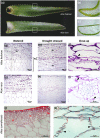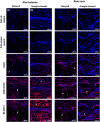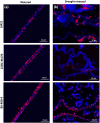Dynamics of intracellular mannan and cell wall folding in the drought responses of succulent Aloe species
- PMID: 30980422
- PMCID: PMC6851777
- DOI: 10.1111/pce.13560
Dynamics of intracellular mannan and cell wall folding in the drought responses of succulent Aloe species
Abstract
Plants have evolved a multitude of adaptations to survive extreme conditions. Succulent plants have the capacity to tolerate periodically dry environments, due to their ability to retain water in a specialized tissue, termed hydrenchyma. Cell wall polysaccharides are important components of water storage in hydrenchyma cells. However, the role of the cell wall and its polysaccharide composition in relation to drought resistance of succulent plants are unknown. We investigate the drought response of leaf-succulent Aloe (Asphodelaceae) species using a combination of histological microscopy, quantification of water content, and comprehensive microarray polymer profiling. We observed a previously unreported mode of polysaccharide and cell wall structural dynamics triggered by water shortage. Microscopical analysis of the hydrenchyma cell walls revealed highly regular folding patterns indicative of predetermined cell wall mechanics in the remobilization of stored water and the possible role of homogalacturonan in this process. The in situ distribution of mannans in distinct intracellular compartments during drought, for storage, and apparent upregulation of pectins, imparting flexibility to the cell wall, facilitate elaborate cell wall folding during drought stress. We conclude that cell wall polysaccharide composition plays an important role in water storage and drought response in Aloe.
Keywords: Aloe; CoMPP; adaptation; drought; hydrenchyma; leaf anatomy; morphology; plant cell walls; polysaccharides; succulence.
© 2019 The Authors Plant, Cell & Environment Published by John Wiley & Sons Ltd.
Conflict of interest statement
The authors declare that they have no conflict of interest.
Figures







References
-
- Ahl, L. I. , Grace, O. M. , Pedersen, H. L. , Willats, W. G. T. , Jørgensen, B. , & Rønsted, N. (2018). Analyses of Aloe polysaccharides using carbohydrate microarray profiling. Journal of AOAC International, 101, 1711–1719. - PubMed
-
- Albersheim, P. , Darvill, A. , Roberts, K. , Sederoff, R. , & Staehelin, A. (2011). Plant cell walls: From chemistry to biology. New York: Garland Science.
-
- Beaumont, J. , Cutler, D. F. , Reynolds, T. , & Vaughan, J. G. (1985). The secretory tissue of aloes and their allies. Israel Journal of Botany, 34, 265–282.
Publication types
MeSH terms
Substances
LinkOut - more resources
Full Text Sources

